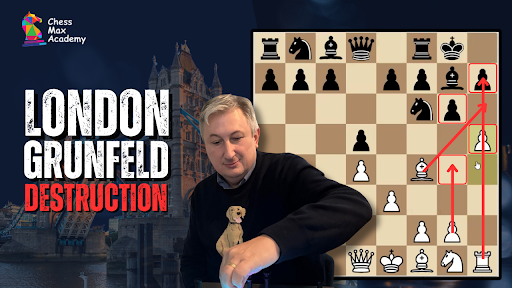The London System, commonly known as the London Opening in chess, is a popular and flexible opening system for White. It starts with the moves 1. d4 and 2. Bf4. This setup is known for its solid structure and adaptability, making it suitable for players of all levels, from beginners to grandmasters.

The London System Set-up
The Grünfeld Defense is a dynamic and hypermodern chess opening that arises after the moves 1. d4 Nf6 2. c4 g6 3. Nc3 d5. It was popularized in the 1920s by Austrian chess master Ernst Grünfeld and has since been adopted by many world-class players, including Bobby Fischer, Garry Kasparov, and Magnus Carlsen.
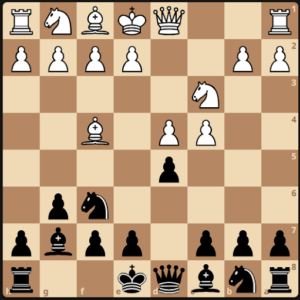
In this game (played online), GM Max Dlugy matched up against a FIDE Master. The game starts with 1.d4 Nf6 2.Bf4 g6 3.Nc3 d5 4.e3 Bg7. Black fianchettoed the bishop on g7, providing pressure on the center and flexibility in the pawn structure. The main idea is to eventually challenge White’s central pawn structure with …c5.
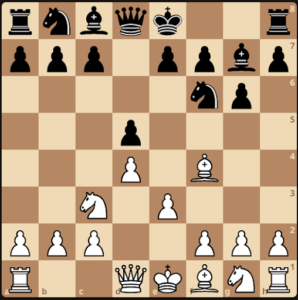
In move 5, GM Dlugy went for an immediate h4, a popular attacking line against the Grunfeld and King’s Indian Defense. The move h4 is designed to immediately gain space on the kingside and prepare for a possible pawn storm or to support the move h5, which can be used to attack the fianchettoed bishop on g7 or create weaknesses in Black’s pawn structure.

Black ignored it and just castled kingside 0-0, allowing white to push the h-pawn to h5. Then followed …c5 7. hxg6 hxg6 8. Qd2 Nc6 9. 0-0-0. Black is planning to create a counterplay in the center and create threats in the quenside but after… Bf5 10. f3 Qa5, GM Dlugy has a better positional advantage and attacking chances.
In this position, GM Dlugy is planning to attack the kingside with g4, Qh2, and Bh6.
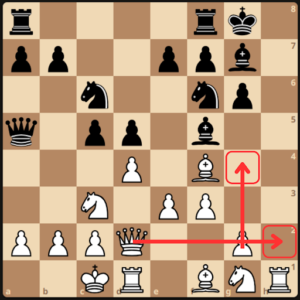
Position after move 10
The game continued with 11.g4 Be6 12.Qh2 Rfc8 13.Bh6 Bh8 14Bf8. GM Dlugy is now threatening mate in 1 with Qxh8+. …Nh5 is forced to resist the attack on the h-file but black played 14…Kxf8. White then captured the bishop on h8 and black blocked the check with Ng8.
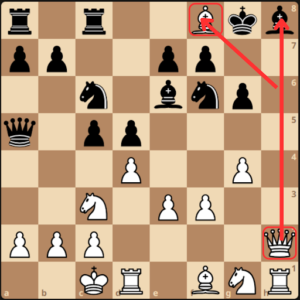
GM Dlugy pushed his rook to h7, threatening Qg7+ to win the knight. The problem for Black is there is no counterplay on the queenside. Black continued with 16…cxd4 17.exd4.
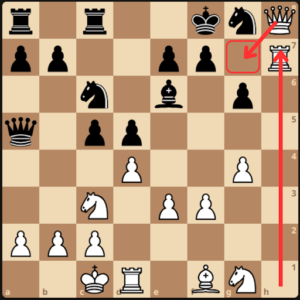
In this position, Black can reply with 17…f6 – 18.Qg7+ Ke8 19. Qxg6+ and hide his king to d7 to prolong the game and create strategic opportunities.
Instead, the FIDE Master replied with 17…Nb4, attacking the a1 pawn.
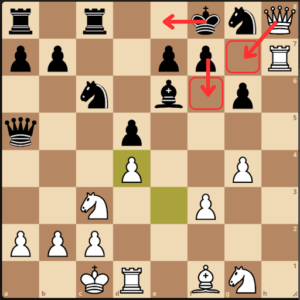
GM Dlugy responded with 18.Bb5, controlling the a4-e8 diagonal and the only escape square for the black king, threatening mate in 1 via Qg7+.
Black’s threat of Nxa2 is not that serious because white can just move his king to d2 and defend.
18…Nc6 is forced and GM Dlugy grabbed the free knight with 19.Qg7+ Ke8 20.Qxg8+ Qd7 21.Qg7.
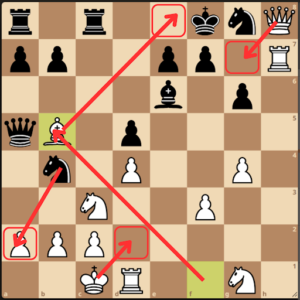
Black responded with 21…a6, attacking the bishop but GM Dlugy just traded it for the knight. When you have a significant material advantage, it’s a key principle to not complicate the game. Trading pieces (not pawns) tends to favor the side with a material advantage. Fewer pieces mean fewer complications and reduce the chances of a counterattack by your opponent.
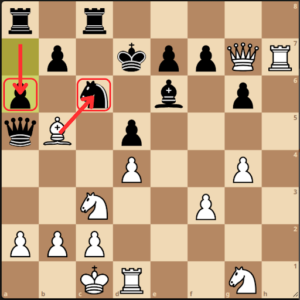
GM Dlugy traded his bishop 22.Bxc6, black recaptured with Rxc6. White developed his knight with 23.Nge2 and the FIDE Master pushed his b-pawn to b5, wanting to occupy the b4 square.
White moved 24.a3 to meet b4 and black responded with Rac8 trying to put pressure on the c-file.

GM Dlugy played 25.Qe5, putting pressure on the d5 pawn with Nxd5 and Nf4 ideas. Out of desperation and lack of counterplay, Black replied with 25…Rxc3, trading his rooks for the knights.
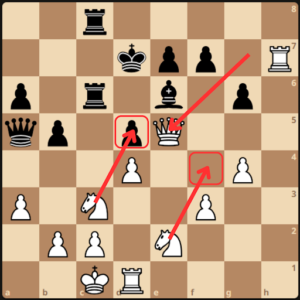
After the trade 25…Rxc3 26.Nxc3 Rxc3 27.bxc3 Qxc3, black is now hopeless as there are no threats. The game continued 28.Rd3 Qa1+ 29.Kd2 and black is totally losing.

GM Dlugy can just play 30. Rc3 and create a mating net. Black’s bishop can’t defend and his queen is on the edge of the board. Black resigned.
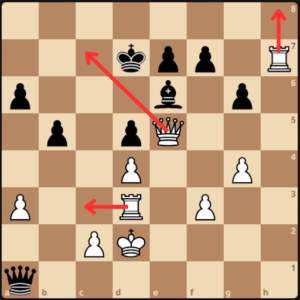
Summary
When playing the Grunfeld or King’s Indian against a London system, it’s important to watch out for white’s immediate h4.
White’s h4 move signals an aggressive intention to push h5, potentially opening the h-file for an attack on Black’s king, especially if Black has castled kingside. This can be combined with moves like g4 and h5, putting pressure on Black’s position and creating attacking chances.
Flexibility in your plan is crucial. Depending on White’s setup, you might need to adapt by delaying kingside castling, preparing to counterattack, or considering alternative strategies.
In this game, black’s 9th move Bf5 gave tempo for White, allowing g4-Qh2-Bh6 attacking ideas.
Remember that both the Grunfeld and King’s Indian defenses often rely on counterplay and central control. While dealing with White’s h4, keep an eye on opportunities to strike back in the center or on the queenside. Understanding these factors will help you better navigate the complications arising from White’s h4 move in these defenses.
Click here to watch the full video:









